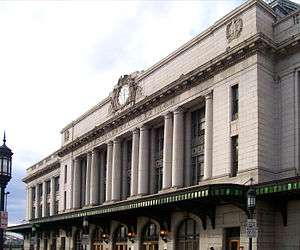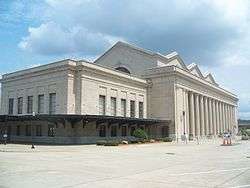Kenneth MacKenzie Murchison
Kenneth MacKenzie Murchison, Jr. (September 29, 1872 – December 15, 1938) was a prominent American Beaux-Arts and Gothic Revival architect.
Kenneth MacKenzie Murchison, Jr. | |
|---|---|
| Born | September 29, 1872 |
| Died | December 15, 1938 (aged 66) New York City, New York, U.S. |
| Nationality | American |
| Alma mater |
|
| Occupation | Architect |
| Spouse(s) | Aurelie deMauriac (m. 1902–1938) |
| Children |
|
| Parent(s) |
|
Early life
He was born in Brooklyn, New York City in 1872. Murchison graduated from Columbia University in 1894 and from the École nationale supérieure des Beaux-Arts in Paris, France, in 1900.[1]
Career
Two years after graduating from the École des Beaux-Arts, he opened an office in New York where his first major commissions were for railroad stations for the Pennsylvania Railroad company. Among the stations he designed are the Delaware Lackawanna Station, Hoboken, New Jersey;[2][3] both the Lackawanna Terminal and the Lehigh Valley Terminal in Buffalo, New York, and Pennsylvania Station, Baltimore, Maryland.[4]
In New York, he was well known as one of the founders of the Beaux Arts Balls, elaborate costume parties benefiting architects who had fallen on hard times. He also was a founder of the Mendelsohn Glee Club. At the time of his death, he had started work on a new Dunes Club to replace the one destroyed a few months earlier.[1]
Personal life
On April 5, 1902, Murchison was married to Aurelie de Mauriac. The family lived in the Beaux Arts Apartments, which he designed, at 310 E. 44th St. Together, they were the parents of two daughters:[1]
- Katherine Murchison, who married Hays Browning.[1]
- Aurelie Murchison, who married Edoard de Wardener.[1]
Murchison died suddenly, at 11:45 p.m. on December 15, 1938, "as he was emerging from the I.R.T. station in Grand Central Terminal", The New York Times reported.[1]
Buildings
| Name | Location | Date | Built for | Current use | Image |
|---|---|---|---|---|---|
| Delaware, Lackawanna and Western Railroad Station | 1 Hudson Place, Hoboken, New Jersey | 1907 | Lackawanna Railroad | Railroad station |  |
| Delaware, Lackawanna and Western Railroad Station | 700 Lackawanna Ave at Jefferson Ave, Scranton, Pennsylvania | 1908 | Lackawanna Railroad | Hotel |  |
| Beaux Arts Apartments | 310 E. 44th St., New York | 1929–1930 | Apartments | ||
| U.S. Marine Hospital | Staten Island, New York | ||||
| Havana Central railway station | 401 Avenida de Bélgica, Havana, Cuba | 1912 | Congress of Cuba | Railroad station |
|
| Munson Steamship Lines Building[5] | 1 Wall Street Court, New York City | 1906 | Munson Steamship Company | Co-op (converted in 2003) | |
| Pennsylvania Station | 47 Walnut St, Johnstown, Pennsylvania | 1916 | Pennsylvania Railroad |  | |
| Pennsylvania Station[6] | 1515 N Charles St, Baltimore, Maryland | 1911 | Pennsylvania Railroad |  | |
| Union Station | 1000 Water St at Park St, Jacksonville, Florida | 1919 | Florida East Coast Railway, et al. | Convention center |  |
He also designed:
- Johnstown, Pennsylvania, Station-Johnstown (Amtrak station)
- Jamaica (LIRR station), Jamaica, New York.
- Long Beach (LIRR station), Long Beach, New York.
- The original Dunes Club, Narragansett, Rhode Island. (Only the gatehouse remains after the 1938 hurricane.)
- Sands Point Bath Club, East Egg, LI (destroyed by fire in 1986)
- Forest Hills Stadium, West Side Tennis Club, Forest Hills, Queens, New York City[7]
- New Colonial Hotel, Nassau
- First National Bank Building, Hoboken, New Jersey
- The Murchison Building, Wilmington, North Carolina
- Co-op Apartments, 39 E. 79th St., New York.
- The Tully House (Residence), Mill Neck, New York
- Luola Chapel, built at Orton Plantation in Brunswick, North Carolina, in memory of his sister who died in 1916. He also added wings to the main house.
- Summer Residences, Narragansett, Rhode Island
- Primelles Building, Havana, Cuba (American Architect. Vol. 119, Part 1)
- St. Elmo Hall, home to the St. Elmo Society, at 111 Grove Street at Yale University, today known as Rosenfeld Hall.
- William A. Clark House (with Lord and Hewlett)
References
- http://articles.baltimoresun.com/2011-09-25/news/bs-md-backstory-murchison25-20110925_1_architect-terminals-baltimore-s-penn-station/2
- Railroad Gazette. Railroad gazette. 1905-01-01.
- Barron, James (September 30, 2016). "Hoboken Terminal, With Flair and Grandeur, Is a Survivor". The New York Times.
- Dorsey, John and James D Dilts, ‘’A Guide to Baltimore Architecture’’, Tidewater Publishers, Centerville, Maryland, 1981 p 281-282
- "Archived copy". Archived from the original on 2011-05-06. Retrieved 2011-11-18.CS1 maint: archived copy as title (link)
- Dorsey, John and James D Dilts, ‘’A Guide to Baltimore Architecture’’, Tidewater Publishers, Centerville, Maryland, 1981 p 178-179
- http://www.queensledger.com/view/full_story/22026912/article-The-architect-behind-the-Forest-Hills-stadium
